Imagine you are starting a new job. It’s your first job in an industry you have no prior experience. What do you do on your first day?… Panic!
For new hires, getting adjusted to the company norms, cultures, rules and regulations, policies, procedures, and processes can become a nightmare. A new hire doesn’t know how things work, where to look for answers, or whom to contact.
So, how do you make sure your new employee doesn’t have a panic attack? Instead, they have a smooth transition in your company, are provided with all the information they need to start off with work, and know all about the company’s work culture. Through an internal company wiki!
An internal wiki helps educate:
- New Employees
- Old Employees
- Transitioning Employees
- Remote Employees
- Employees in Global Offices
There are numerous use cases.
Once your company decides to create an internal wiki, you’ll wonder how you survived without one for so long!
So without further ado, let’s dive deep into what’s an internal wiki and why it’s absolutely important for every business to have one.
What’s an Internal Wiki? (Definition)
I’m pretty sure the first thing that came to your mind when you heard the term wiki was Wikipedia, the online encyclopedia, right? Well, you’re not entirely wrong in making that connection.
Wiki comes from the Hawaiian word for “quick. “ Wikipedia defines a wiki as “A website on which users collaboratively modify content and structure directly from the web browser. In a typical wiki, the text is written using a simplified markup language and often edited with the help of a rich-text editor.”
Since Wikipedia acts as the single source of all knowledge on the internet, created collaboratively by people from all over the world, and can be edited by anyone, a wiki acts as a single source of all knowledge for an organization which can be too, created, edited and modified by any employee of the organization.
An internal wiki, or corporate wiki, functions as a central repository for managing and distributing all company knowledge and information.
It’s a place where all your co-workers can store internal documentation about company policies, processes, how-to guides, projects or products they are building, common workflows, shared logins, procedure checklists, etc. Think of an internal wiki as a Wikipedia made specifically for your company.
Cool right?
Don’t even get started on the key component to set up an awesome wiki for your company…search. Anyone in your organization can search and find answers to the questions they have. Nothing is better than encouraging employees to be proactive and reduce that shoulder tapping.
Why Does Every Company Need an Internal Wiki?
A study conducted by McKinsey & Company shows that employees spend 19% of an average workweek trying to gather the information needed to complete a task.
However, when companies use an internal knowledge base to store their data, employee productivity can boost by as much as 35%!
All the giants of the world, like Google, Microsoft, and Apple, use an internal wiki to keep their knowledge safe and accessible. A great wiki helps to boost employee productivity and efficiency, thereby saving a ton of money!
Let’s break down the key reasons why an internal wiki is absolutely necessary:
1. Improving Collaboration and Communication
A huge part of an internal wiki is the ability to collaborate with your team. It’s important to create and edit information together. It helps with transparency and improved communication among employees.
- Managers can update SOPs (standard operating procedures)
- Project managers can keep project status updated
- HR Teams can update ethics policies
- Developers can share code & resources
- Design teams can update brand style guides
You get the point. The use cases are endless!

2. Onboard New Team Members Faster
Training new employees and getting them up to speed with the rest of the organization can be challenging.
Going back to the beginning of this blog post, remember how we talked about how difficult it could be for new employees to adjust to a new company or industry without having any prior knowledge of the practices, procedures, standards, etc.?
A massive 40% of employees with poor training leave their jobs within the first year. An internal wiki is a great way to overcome that challenge.
The wiki in your organization becomes the go-to place to store:
- Guidelines
- Checklists
- How-to guides
- Customer support material
- Training documents
- Design material (logos, etc.)
- Business Policies
- Best practices and more!
Basically, all the important stuff you and your team have learned over time. It’s impossible to feed an employee with everything that is in your brain.
The best way is for a new hire to be resourceful and seek out answers to questions they have. Just like all of us turn to Wikipedia online to answer our most pressing questions, it’s important your employees have access to something similar to your company.
Did you know that companies that invest in employee training enjoy a 24% higher profit margin versus companies who don’t? Investing in an internal wiki could just prove out to be your best investment yet!
3. Knowledge Retention
Imagine if a key employee or manager with years of experience decides to work somewhere else or retires? He/she takes their knowledge with them and it becomes an uphill battle to replace them.
- Their on-the-job experience is lost.
- How they viewed and looked at issues is lost
- Strategies or tactics they used are lost.
- How they managed projects is lost.
- The research they conducted is lost.

Simply put, it’s impossible to replace and find someone who has the exact experience they brought and learned at your company. This is why an internal wiki plays a crucial role in the organization.
An internal wiki allows businesses to capture all of this vital knowledge of their employees and keep it in a safe repository. This way, when employees leave, their knowledge doesn’t leave with them. Your current or future employees can easily access this information and continue doing their work.
Checklist For an Ideal Internal Wiki
The perfect internal wiki should have all these essential features for it to be successful:
Internal Company Wiki Checklist:
- Real-time collaboration between employees.
- Provide separate digital workspaces for people to work in teams.
- Robust content management system to store all of the company’s files and documents- PDFs, excel sheets, guides, training documents and videos, images, etc.
- Strong search capabilities to quickly browse through files and folders and provide employees what they are looking for quickly and easily.
- Protect the information stored in the wiki from outsiders and or anyone without the proper consent to access that information.
It’s difficult to find a tool that has all the above-mentioned features and is easy to use. That is why we came up with Bit, the best workplace collaboration tool to create your own internal wiki.
Bit.ai is an AI-powered wiki and document collaboration tool that helps teams to collaborate, share, track and manage all company knowledge in one place. Here is how you can host internal wiki on Bit.
Why Host Your Internal Wiki on Bit.ai?
Bit.ai is the perfect platform to host your internal wiki. You will be able to easily share and edit information about procedures, processes, methodology, code, checklists, training documents, how-to guides, company policies, process documentation, and various other workplace documents.

Here are some of the ways Bit is going to make your workplace wiki life amazing:
1. Team Workspaces
Think of workspaces as your virtual hub, where all the activities happen. It’s like your central command center for storing and organizing information.
Within a workspace, you can create different types of workspaces to suit your needs. Whether it’s private for individual or confidential work, team-based for collaboration within specific teams, or department-based for organizing work according to different departments, Bit.ai has you covered. You can also create cross-functional teams for projects involving multiple departments or project-based workspaces for organizing work related to specific projects, to name a few.

Once you’ve chosen the type of workspace that suits your needs, you can start adding content. To give you more control over what is created within the workspace, Bit.ai’s workspace insights provide a comprehensive overview of workspace activities and documents, including recent activity logs and documents with live sharing enabled. This helps you stay organized and track progress effectively.
Another useful feature is the Asset Library. This allows you to pre-upload digital content that you and your team can add to the knowledge you’re creating. Whether it’s attachments, files, images, or rich embeds, the asset library accelerates document and wiki creation by providing easy access to frequently used content.
Additionally, Bit.ai offers role-based user access, giving you control over who can edit, invite, share, and manage content within your workspace. From full access to read-only, you can customize access levels to suit your team’s needs.
2. Real-time Collaboration
With Bit.ai, multiple collaborators can edit the document simultaneously. This means you can all work together seamlessly without worrying about conflicting versions or delays. Changes made by your teammates appear instantly. You’ll never have to hit refresh or wonder if you’re looking at the most up-to-date version. Everything updates automatically, keeping you in sync with your team’s progress.
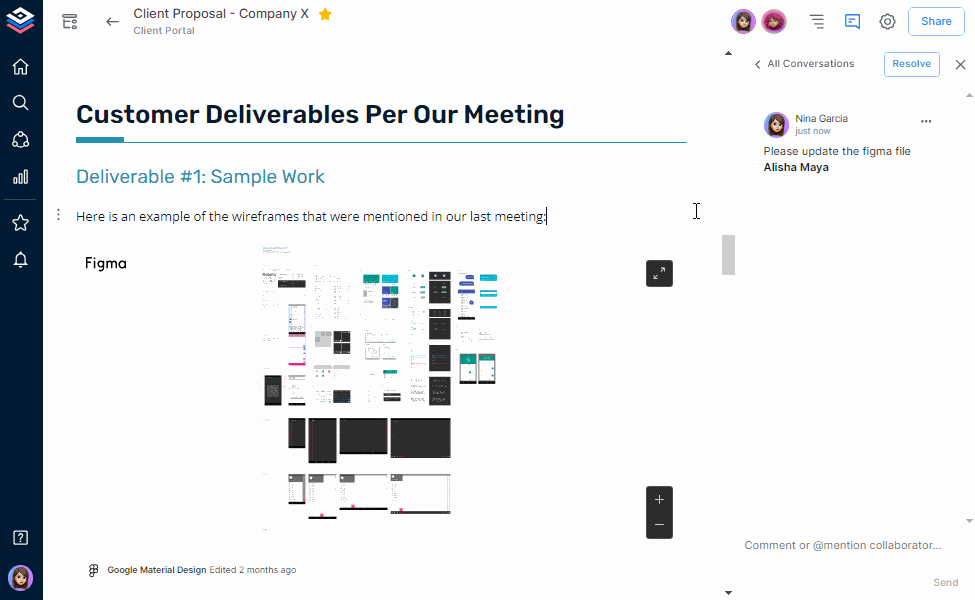
But what if you want to communicate with a specific teammate about a particular section or idea? Well, Bit.ai has got you covered with its inline comments feature. You can comment directly on the document by mentioning a collaborator using the ‘@’ symbol followed by their name. They’ll receive in-app and email notifications about your comments, ensuring they’re always in the loop.
3. Smart Living Documents
With Bit.ai’s interactive living documents, you can create a knowledge hub that’s not only informative but also engaging and easy to navigate. Let’s dive into how you can get started and explore the awesome features Bit.ai has to offer.
With Bit.ai’s smart editor, say goodbye to cluttered top ribbon bars that you find in other document creation tools. Simply highlight the text you want to format, and voila! You’re on your way to creating beautifully formatted content. And if you’re a fan of keyboard shortcuts,, you’re in luck – Bit.ai has got you covered with a comprehensive list of shortcuts that are both easy to learn and fun to use.
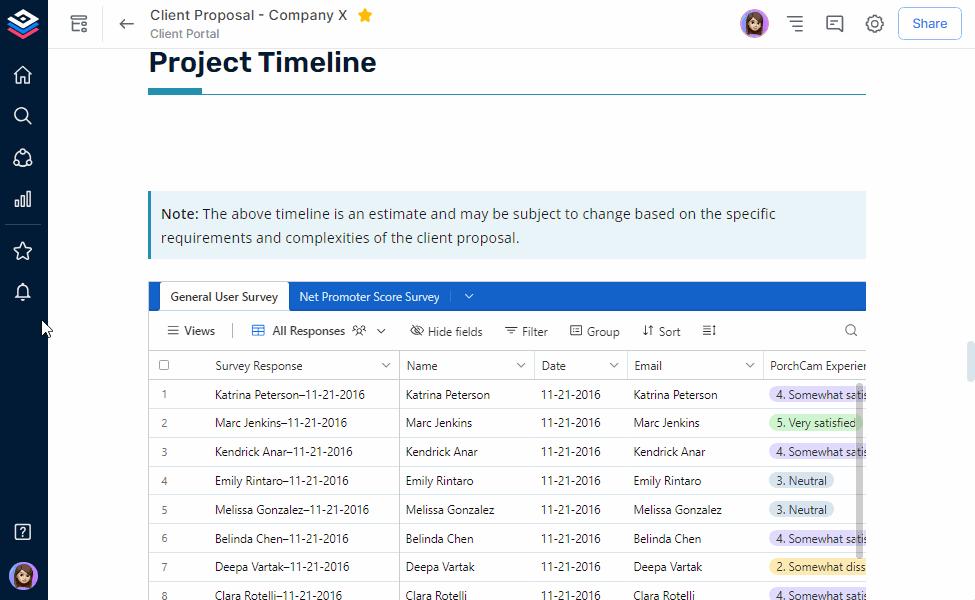
Moreover, adding hyperlinks to your documents has never been easier. Whether you’re pasting URLs or creating anchor links for seamless navigation, Bit.ai makes it a breeze. And speaking of navigation, you can also interlink documents to create a web of interconnected subpages, making organization a piece of cake.
But wait, there’s more! Introducing smart widgets – your ticket to integrating diverse content into your documents. Whether you’re adding images, files, tables, or code blocks, smart widgets have got you covered. With features like customizable adding titles, descriptions, and sizes, you can tailor your content to suit your team’s needs. The file preview option makes it easier to see the file in your smart doc. No need to open the file separately!
Hate scrolling endlessly to find what you’re looking for? With an automated table of contents that updates dynamically as you add or edit headings (H1 – H3), navigating through your documents is a breeze. Plus, you can use the table of contents to create hyperlinks and anchor links within your document, making it even easier for your team to find the information they need.
They say first impressions are everything – and that’s where design automation comes in. With just a click, you can pick themes, fonts, and colors to give your documents a polished and professional appearance. Whether you’re creating a presentation or designing a marketing brochure, design automation ensures that your documents look sleek and stylish every time.
4. Smart Wikis
One of the best features of Bit.ai is its ability to transform any document into a wiki by adding subpages linked through a navigation panel. You can have a single platform where you can store all your important information – from personal notes to technical documentation and everything in between.

But the benefits don’t stop there – with Bit.ai, you can create an unlimited hierarchy of subpages within subpages, allowing you to organize your information in whatever way works best for you. Whether you’re breaking down complex processes into manageable steps or creating a comprehensive knowledge base for your team, Bit.ai’s smart wiki gives you the flexibility and scalability you need to succeed. To rearrange the subpages, simply hover over any subpage on the wiki tree, click and drag it to the desired location.
5. AI Genius
Everyone values their time, especially when it comes to work. That’s why Bit.ai offers the AI genius writer – your ultimate productivity tool. AI genius is like having a virtual assistant at your fingertips, ready to help you create, collaborate, and share knowledge faster than ever before.
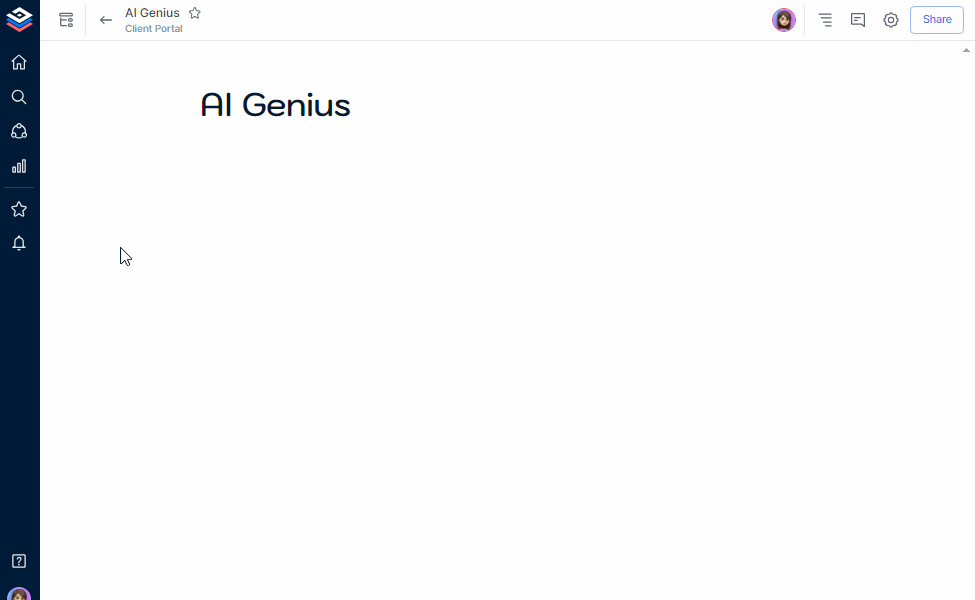
You can simply type ‘@’ and ask an AI genius for whatever you need. Responses are automatically formatted according to your document theme, making it visually appealing and easy to work with in the editor. You can customize your document design beforehand to match your preferences, and the AI genius responses will automatically adapt to your chosen design.
From creating templates and brainstorming ideas to conducting research and weighing the pros and cons of different options, Bit’s AI genius writing assistant is your go-to tool for simplifying your work and saving time.
6. Smart Search
What good is a repository of knowledge if you can’t quickly and easily access the information you need? As an employee, you don’t have enough time to go looking for a particular file in each and every folder, and with smart search, you don’t have to.
You can find smart search conveniently located on the left side of the platform, making it easily accessible no matter where you are within the application. With smart search, you can conduct searches across various elements, including workspaces, folders, wikis, document titles, and even content within documents. This means you can quickly locate the information you need without wasting time hunting through multiple folders or documents.
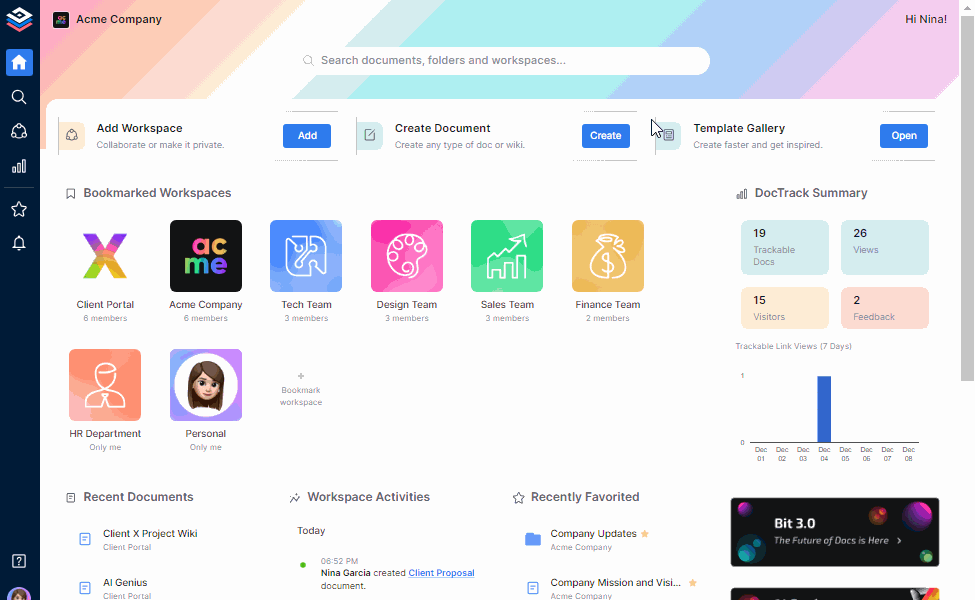
But here’s where it gets even better – when you click on search results for a specific document or wiki subpage, Bit.ai takes you directly to the exact location within the document or subpage. This saves you from having to scroll through lengthy documents to find what you’re looking for. Whether you’re searching for a specific topic, keyword, or even a sentence within a document, smart search has got you covered.
7. External Wiki
Imagine you’ve created a comprehensive wiki filled with valuable information for your team. Now, you want to share it with external partners for feedback. Bit.ai makes this process seamless with its external sharing features. Let’s explore how you can share your content effectively.
1. Share Live Document:
Suppose you’ve compiled a detailed project report in Bit.ai, and you need to share it with your stakeholders. By generating a shareable link, you can provide them with read-only access to the live document. This means they can view the report in a visually appealing format on any device, easily navigate through the table of contents, and find specific information using the smart search feature.
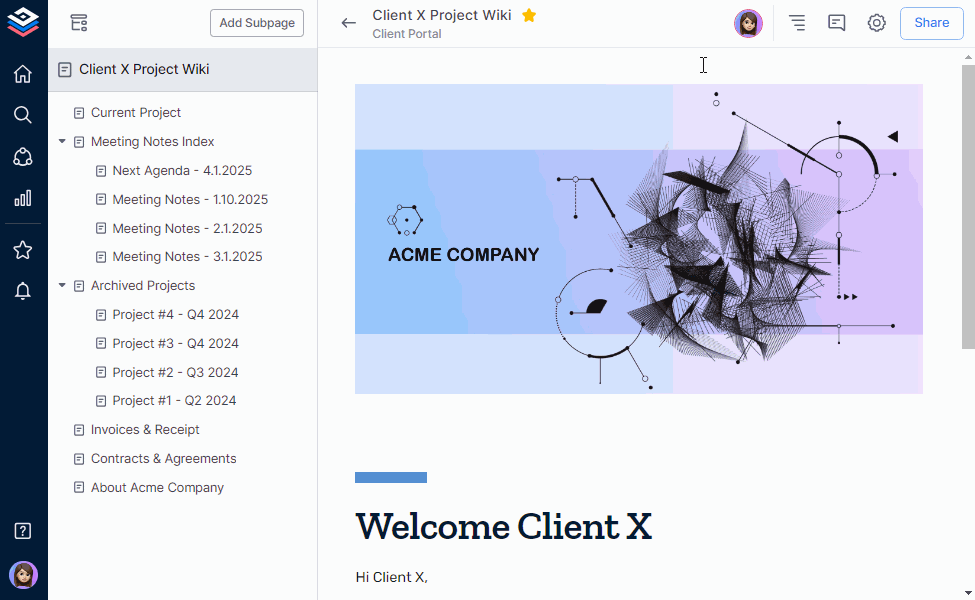
2. Embed Document:
Maybe you have a company blog where you want to showcase your team’s latest accomplishments. With Bit.ai’s embed feature, you can seamlessly integrate your project reports or wikis directly into your blog posts. This allows your blog visitors to access the information without leaving the page, enhancing their browsing experience. Features like the table of contents and dark mode toggle ensure that the embedded document remains user-friendly and accessible.
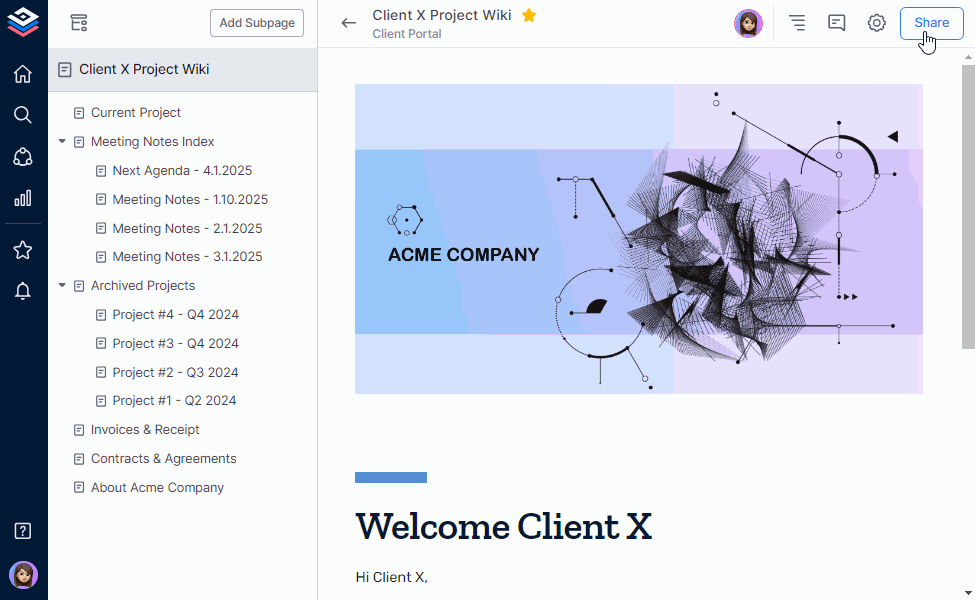
3. Inviting Guests to a Workspace:
Let’s say you’re working on a collaborative project with external consultants. You can invite them to a dedicated workspace in Bit.ai, where they can access project documents and contribute their insights.
With authenticated guest access, you have control over what they can view and edit, ensuring confidentiality and security. This feature transforms your workspace into a hub for collaboration, where both internal and external stakeholders can work together seamlessly. You can easily turn your workspace into a client portal or a dataroom with this feature.
4. Create Trackable Links:
Let’s say you’ve created an important document that you want to share with your team or clients. With Bit.ai, you can create trackable links to monitor how people interact with your document. Here’s how it works:
When you create a trackable link, you can customize the title to make it easy to identify. You can also add notes to remind yourself or others about the document’s purpose.
To make your link even more personalized, you can create a landing page that reflects your brand or message. This makes the experience more enjoyable for whoever clicks on the link.
![]()
If you’re worried about security control, don’t worry! You can add a password to your trackable link, so only people with the password can access it. You can also set an expiration date so the link automatically stops working after a certain time.
But that’s not all! You can also add an optional lead capture form to your trackable link. This is useful if you want to collect information from people before they access your document. You can ask for things like their name, email, or company.
Once your trackable link is out in the world, you can keep track of how it’s doing using Bit.ai’s analytics. You can see how many people have visited the link, how many views it’s gotten, and even get feedback from your audience.
With all these features, creating trackable links with Bit.ai gives you valuable insights into how people are engaging with your content. This helps you make smarter decisions about your content strategy and improve your documents over time.
8. Version History
Bit.ai’s version history keeps track of all the changes made to your files over time, creating snapshots of each version along the way. This means that even if something goes wrong, you can easily go back in time and restore a previous version of your document with just a few clicks.

But that’s not all! With version history, you can also see who made changes to the document and when they were made. This is super helpful for keeping track of everyone’s contributions and collaborating more effectively as a team. Plus, it gives you peace of mind knowing that you can always revert to a previous version if needed.
So, whether you accidentally delete something important or want to see how your document has evolved over time, Bit.ai’s Version History feature has got you covered.
Pin this for future reference!
Going forward, What’s next?
If your company doesn’t have an internal wiki yet, we’d encourage you to give it a try. The goal of an internal wiki is to streamline the various types of information scattered around your organization and make it available to everyone.
The ability to create and edit stuff collaboratively is a must for an internal wiki. Another key feature you should look for while creating an internal wiki is its ability to perform really advanced, deep, and in general, smart searches across the platform.
Only when the right information is accessed at the right time and by the right person can the purpose of knowledge and information management can prove to be successful and efficient.
In short, if your employees prefer searching the internal wiki instead of Google or Wikipedia, you have done your job!
Further Reads:
- Business Wiki: The Ultimate Guide To Create One For Your Company!
- Corporate Wiki Guide for All Types of Businesses!
- Wiki Sites: What are They & How To Create a Wiki?
- Internal Wiki vs. External Wiki: The Key Differences You Need to Know!
- Company Wiki Vs Knowledge Base: Understanding The Key Differences!
- Private Wiki: How to Create a Visually Appealing One?
- Discover the Best Wiki Software: Its Types and Benefits


